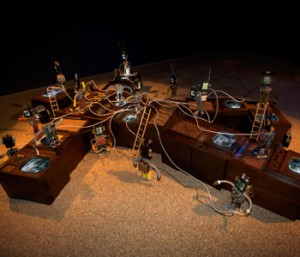 Beginning April 10, and running through June 27, 2010, the Jordan Schnitzer Museum of Art will present the Eugene premiere of Media Alchemy of Nam June Paik, a selection of work by the internationally acclaimed late pioneering video artist.
Beginning April 10, and running through June 27, 2010, the Jordan Schnitzer Museum of Art will present the Eugene premiere of Media Alchemy of Nam June Paik, a selection of work by the internationally acclaimed late pioneering video artist.
Born in Korea in 1932, Nam June Paik is credited by many as the first video artist. As a child, he was trained as a classical pianist, and later studied the history of music at Munich University. There, encounters with composers Karlheinz Stockhausen and John Cage and conceptual artist Joseph Beuys inspired him to work in the field of electronic art and to ally himself with Fluxus, a Neo-Dada art movement. In the early ’60s, now living in New York, Paik worked with classical cellist Charlotte Moorman. The video-music-performances piece they created included TV Cello and the notorious TV Bra for Living Sculpture. Paik began creating other sculptural video pieces, including robots made from television sets and the famous TV Buddha, depicting a Buddha contemplating a miniature TV. In the 1970s he began a series of tapes, including Global Groove (1973), that applied surreal conceptual wit and neo- Dada irony and which appropriated and derailed the familiar syntax of commercial television. Many were made with the aid of a video synthesizer of his own invention. From 1979 to 1996 he was professor at the Kunstakademie Düsseldorf, the Arts Academy of Düsseldorf, Germany. Paik died in 2006.
The Jordan Schnitzer Museum of Art exhibition presents a range of Paik’s re-used technology, discarded televisions, radios, and an assortment of electronic gadgetry and popular imagery, fashioned into bodily forms. The five featured works are:
Gulliver (2001) depicts the capture of Jonathan Swift’s character, built from 11 antique TV cabinets with working screens and one antique radio cabinet, by 18 Lilliputians of mixed media, including 5” LCD TV screen heads.
Internet Dweller (2004) is number five in a series of 12 Internet Dwellers. The piece consists of 1950s-era technological elements, from two television cabinets to clocks and circuit boards with a 1950s light fixture on top.
Neon TV (1990) illustrates the end of communism, and is constructed of a television set that has Asian writings painted in black on the screen within which sit three Sony Watchman television sets as well as many electronic gadgets.
Global Groove (1973) is a 30-minute, fast-moving montage of imagery ranging from 1960s rock and political dogma to African dance.
TV Clock (1963) is composed of 24 fixed-image color television monitors. Each monitor is displayed on a pedestal and arranged in a semi-circle depicting a different hour of the day.
Cinema Pacific will open on Wednesday, May 5 with a presentation of Paik’s single-channel tape, Allan n’ Allen’s Complaint, a portrait of artists Allan Kaprow and Allen Ginsberg and their relationships with their fathers. This will be supplemented by a marvelous portrait of Nam June Paik made for public television in 1975, Nam June Paik: Edited for Television. Richard Herskowitz, director of Cinema Pacific, will introduce the videos and conduct a tour of Paik’s gallery exhibit.
Media Alchemy of Nam June Paik is organized by the University of California Irvine’s Beall Center for Art + Technology and curated by David Familian. The exhibition is made possible at the University of Oregon with the support of the Farwest Steel Endowment Fund and the Oregon Korea Foundation.